As a parent, it’s natural to want your children to be healthy – and that includes their teeth. But sadly more than 40% of children have tooth decay by the time they get to kindergarten. While you can take steps to prevent things like cavities and gum disease, some other children’s ordial health problems can happen at any time.
As soon as your child’s first tooth appears you have a part to play in keeping their mouth healthy, so it’s a good idea to be informed about all the things that might affect them in hothe future. Knowing the symptoms of common dental problems means you can identify them early on and seek treatment before they develop too far.

In this article, we’ll answer some questions that many parents have about caring for their children’s teeth and mouth, including:
- Do baby teeth really matter?
- How can I protect against tooth decay?
- What are the signs of gum disease in children?
- Is it normal for babies and children to get mouth ulcers?
- How can I relieve mouth ulcer pain?
- How do I know if my child needs braces?
- What should I do if my child’s tooth is damaged or knocked out?
You’ll also discover how your child’s oral hygiene routines should change during the different stages of their life – from baby to toddler to school age.
This infographic shows some of the most important points relating to this topic: the problems to look out for and ways to keep children’s teeth healthier. After this you’ll find lots more in-depth information to help you improve your child’s oral health.
We hope all this information gives you more confidence when it comes to dental health for your child. Getting it right now will help them develop healthier habits as they grow up, so it’s worth investing the time early on.
In This Article
Children’s Dental Health
The importance of baby teeth
You might be wondering how much milk teeth really matter since they’re only temporary anyway. Well, there are several reasons why baby teeth need just as much care as adult teeth.
- Pain and discomfort: If you’ve ever suffered from a toothache yourself, you’ll know how unpleasant it is. If your child’s teeth become rotten, they’ll be suffering from that pain until the teeth fall out or are removed. Bear in mind that the last baby teeth can remain until age 12 or 13.
- Appearance: There is nothing cute about a child with a smile full of black teeth. Even if they don’t seem that bothered by them, other people are bound to notice and this may lead to teasing at school.
- Speech: We need our teeth to help us pronounce words properly. If your child is missing some baby teeth for an extended period of time, it may affect their speech development.
- Healthy adult teeth: Baby teeth have a direct effect on permanent teeth in a couple of ways. Firstly, they save space for the adult tooth to erupt into. If the baby tooth is removed early, other teeth can fill that space, causing problems with the eruption of the adult tooth and increasing the chances of needing braces. Secondly, if decay spreads deep enough into the root of the baby tooth it can actually reach the adult tooth tucked up underneath it – even before that tooth has erupted.
Despite all of this, tooth decay is the number one chronic childhood illness in the USA. In the video below, a dentist explains the issue of childhood tooth decay and how to prevent it.
If your child’s first experience with the dentist is a negative one, they are less likely to want to visit again in the future – even as an adult. But start young with preventative care and dental checkups won’t become a big ordeal.
The same goes for tooth brushing; if you instil good habits while your child is young then there is a better chance of them continuing these into adulthood.
Remember that oral health isn’t just about teeth. Your child’s gums and the soft tissue in their mouth also contribute to their overall oral health so it’s important to keep an eye on those areas too.
The table below gives a brief overview of some of the oral health problems children might experience, including symptoms, treatments, and measures for prevention. Following this, you can discover more about each of these issues and learn about other ways to protect your child’s teeth.
Problem | Causes | Symptoms | Treatment | Prevention |
Tooth decay | Poor oral hygiene, high-sugar diet | White, brown or black patches on teeth, depending on severity | Fluoride varnish, filling or extraction, depending on severity | Follow good oral hygiene practices and minimize sugar in diet, especially snacks |
Mouth ulcers | Mild infection, sometimes another medical condition | Small, round white sores inside the mouth | None required unless linked to another problem | Not always preventable but avoid damaging soft tissue in the mouth |
Gum disease | Poor oral hygiene | Red, sore, swollen or bleeding gums | Professional teeth cleaning, improve oral hygiene | Follow good oral hygiene practices |
Tooth grinding | Various including airway obstruction, stress and anxiety | Audible grinding noise, constant headache, sore jaw in the morning | Depends on the cause but may include using a mouthguard | Depends on the cause, not always preventable |
Misaligned teeth | Genetic factors, early loss of baby teeth, thumb sucking | Teeth crooked or don’t meet properly when biting | Orthodontic braces | Not always preventable but discourage pacifier use after age 1 and thumb sucking |
Tooth Decay in Children
We’ll start with arguably the biggest dental problem for children in the US: tooth decay (or ‘dental caries’, to give it its proper medical name).
42% of children aged 2-11 have had dental caries in their primary teeth according to 2018 statistics from the National Institute of Dental and Craniofacial Research. The figures are higher for children from lower-income families.
Given that tooth decay is preventable, these numbers shouldn’t be so high.
What causes tooth decay?
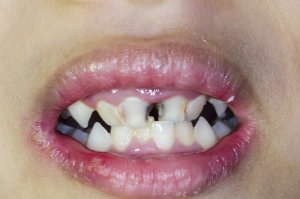
Bacteria in the mouth form a sticky coating on the teeth, called plaque. They feed off sugar found in the food and drink you consume, producing acid in the process. This acid, if allowed to sit on teeth for too long, starts to erode the surface. Over time this results in holes, or cavities, which spread to the inner parts of the tooth and cause toothache.
Sugary foods and drinks are one of the main risk factors associated with tooth decay, and the risk increases when sugary snacks are consumed between meals. Young children who are given sweetened drinks in a bottle or sippy cup at night or throughout the day often develop decay in their upper front teeth. This is sometimes called ‘baby bottle tooth decay’.
Signs of tooth decay
The early stages can be hard to spot unless you know what to look for, so it’s important to visit the dentist regularly. The longer the decay is left to develop, the more complicated it is to treat. Catching it early will make the experience much less traumatic for your child.
Dental caries may first appear as a white line along the gum or white or brown spots on the teeth. As it advances, more noticeable brown or black areas will appear.
Treating dental caries in children
If your dentist spots early stage tooth decay they might simply apply a fluoride gel or varnish, which helps strengthen tooth enamel. This naturally fights decay without affecting the structure of the tooth.
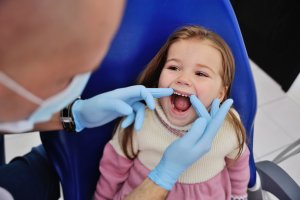
If the decay has developed further, your child may need a tooth filling. This involves removing the rotten part of the tooth and filling it with a white or metallic material.
Extraction is a last resort but it may be necessary if the decay is widespread. Left untreated, tooth decay can become so severe that it can cause malnourishment, anemia, other infections, and more. The Affordable Care Act does cover dental for children but there are limited Medicaid funds allocated to dental care. The good news is that tooth decay is preventable.
Every kiddo is different and not every kid is 100% comfortable at the dentist. Some kids just don’t have the ability to sit still or follow instructions well enough to get the dental care they need. In these cases, sedation dentistry can help. The 3 most common options available are:
- Oral Conscious Sedation – The “lightest” sedation available. Think of it like the difference between “light” and “deep” sleep. Best for shorter treatments with nervous patients. Commonly used along with laughing gas.
- Intravenous (IV) Sedation – A flexible “middle-ground” that can be adjusted to meet the needs of a variety of patients. Deeper IV sedation is commonly used in teens who need their wisdom teeth out.
- General Anesthesia – The deepest form of sedation where the patient is completely “asleep.” Best for patients who simply can’t be awake during treatment or for longer and more involved treatments.
Dr. John Will, Children’s Dentistry of Charlottesville
Preventing tooth decay
There are two main factors that contribute to tooth decay in children: diet and oral hygiene. You might think that it doesn’t matter too much what your child eats as long as they brush their teeth properly afterward. However, a 2017 study showed that tooth brushing can actually only do so much to combat a poor diet.

In fact, brushing directly after eating is not recommended, as your enamel might be weakened from eating acidic foods.
Children under 5 who snack all day rather than eating proper meals are twice as likely to develop tooth decay than those who have regular meals, the study showed. And of course, a high-sugar diet is known to be detrimental to dental health. Be especially careful during the holidays.
Simply put, tooth brushing alone isn’t enough to keep children’s teeth in good health. It also matters what they eat and drink during the day.
Another important treatment that your child’s dentist may recommend is dental sealant, which can prevent around 80% of cavities! Sealant is applied to the tops of molars so that cavities don’t form in the deep fissures that can be hard to clean by brushing. Read more about dental sealant.
Further down in this article you’ll find information on:
- How to brush your child’s teeth properly
- How controlling their diet will reduce their chances of tooth decay
- Other tips for keeping teeth healthy
For more information on tooth decay causes, treatment, and prevention, read our full article about dental cavities.
Other Children’s Oral health Problems
Aside from tooth decay, there are plenty of other oral health problems your child might experience.
If you need to find a dentist for your child now, you can call 866-383-0748. You’ll be connected with a live operator who will put you through to a pediatric dentist in your area.
Otherwise, let’s take a look at some of the potential problems it’s good to be aware of:
Mouth ulcers
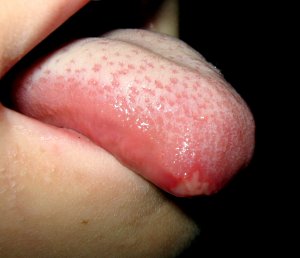
It’s quite common for children to get mouth ulcers at some point, especially between the ages of one and three. Also called canker sores, these usually appear as white, round sores on the tongue, gums and soft tissue in the mouth.
Mouth ulcers in children are usually nothing to worry about and will clear up in a week or two. During this time your child may find it uncomfortable to eat. Avoid very sweet, salty and spicy foods to minimize any pain.
There are, however, some cases where mouth ulcers are a symptom of another problem – especially if more than one or two appear at a time. If your child is in severe pain or shows any other worrying symptoms then seek further medical advice.
Children’s mouth ulcers sometimes occur when a cut in their mouth becomes infected. You can minimize the chances of this by making sure they don’t put anything sharp in their mouth.
Our full guide to mouth ulcers has lots more information on what causes them and how to relieve any discomfort.
Gum disease
Gum disease in children is much less common than in adults, but it can still occur. You might notice your child has red, sore, swollen or bleeding gums, which often makes it uncomfortable for them to eat.
If you spot any of these symptoms, take your child to the dentist. Your dentist will assess their symptoms to determine how far the disease has developed.
When caught in the early stages (known as gingivitis), treatment is quite straightforward. Your child may need a professional tooth cleaning, but after that it’s just a case of maintaining good oral hygiene.
If left for longer, a more serious condition called periodontitis can develop. At this stage, tooth loss is more likely and gums can become severely infected.
You can read more about how to identify and prevent gum disease here.
Tooth grinding
Approximately 15% of children are affected by tooth grinding (bruxism). Since some cases go unreported or unnoticed by parents, the true number is probably higher.
There is no single cause of bruxism in children. It could be something physical, such as an airway obstruction, but it
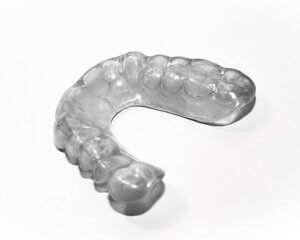
may also be a result of stress or anxiety, for example, because of bullying at school.
Children who grind their teeth at night may show behavioral problems associated with lack of sleep. They may also complain of a constant dull headache or a sore jaw in the morning. Even if you don’t hear the grinding itself, mention it to your dentist if you notice these symptoms.
Tooth grinding should stop once your child has all their adult teeth. If it continues beyond this point your dentist can advise you about possible treatments.
Night guards for teeth grinding may be one solution your dentist may recommend.
For more information about the causes of tooth grinding and what you can do about it, read our article about bruxism.
Misaligned teeth
Once your child’s permanent teeth start erupting, you’re bound to notice how straight (or not) they are. There are a number of factors that may cause crooked teeth, including:
- Extra or missing teeth
- Large teeth
- Small jaws
- Early loss of baby teeth
- Prolonged use of a soother can misalign teeth
- Thumb sucking
- Tongue tie
If your child’s teeth seem to be growing in crooked, try not to worry too much. They may well straighten themselves out as the mouth continues to grow and develop, but even if they don’t there is the option of orthodontic work for teeth straightening. Equally, adult teeth that erupt perfectly straight can later move out of alignment because of overcrowding or some other factor.

It’s important to take your child for regular checkups so your dentist can monitor how their teeth are growing, especially if they use a pacifier. If they develop a malocclusion (misaligned teeth) then your dentist may recommend braces. Getting your child’s teeth straightened won’t just improve the aesthetic appearance; it also makes teeth easier to clean, reducing their chances of oral health problems later in life.
Besides braces, there are more subtle ways to straighten teeth, including clear braces and invisible aligner braces like Invisalign Teen . These are a great option if your child is worried about being bullied for wearing traditional “metal mouth” braces.
Read our full article where you can find out more about the different kinds of braces for kids.
Chipped or cracked tooth
Teeth can become chipped or cracked for a number of reasons. It might be a fall or accident, biting down on something hard, or a weakened structure because of decay or enamel erosion.
Treatment will depend on how serious the damage is. For small chips, dentists can usually just file down any sharp edges to prevent injury inside the mouth. For larger chips, they can often rebuild the tooth structure with a composite material.
If a tooth is badly damaged, extraction may be the only option.
Tooth knocked out
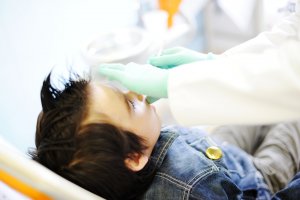
While most of the problems on this list are preventable to some degree, this one definitely isn’t. Sometimes accidents happen and one or more teeth may be knocked out completely.
Here’s what to do if your child’s tooth is knocked out:
- Get to a dentist as soon as possible (you may need to make an appointment with an emergency dentist)
- Retrieve the tooth if possible and keep it in a glass of milk
- Don’t try to place a baby tooth back in the socket as this may damage the adult tooth underneath
The sooner you get medical assistance, the better the chances that the tooth can be re-implanted.
How to Keep Children’s Teeth Healthy
If you want to avoid preventable diseases like dental caries and gingivitis, it’s important to establish a good oral hygiene routine with your child. You also need to control how much sugar they consume, and how often.
How to brush your child’s teeth
As soon as a baby’s first tooth appears, it needs to be brushed to protect it from decay-causing plaque.
Use a toothpaste that contains fluoride, a mineral which helps strengthen enamel and fight decay. Fluoride concentration is measured in parts per million (ppm). Children should use toothpaste containing at least 1,000ppm fluoride. Internationally, it is recommended that 1,000ppm be used up to age six, and 1,350 – 1,500ppm thereafter, but the ADA hasn’t recently specified.
See our guide to toothpaste for babies and children for some product recommendations and other advice about choosing a toothpaste for your kids.
It’s important that young children don’t swallow fluoride toothpaste since this can lead to a condition called dental fluorosis. But what’s more important in controlling your child’s fluoride intake is the amount of toothpaste used. Teach them to spit after brushing and use just a smear of toothpaste (about the size of a grain of rice) until they are three years old. After that, use a pea-sized amount.
You can also supplement your child’s brushing with safe-to-swallow, fluoride-free mouth sprays like this one from Dr. Brite. It features a gentle berry flavor, coconut oil and vitamin C to nourish and clean. You can use discount code DRBRITE10 to get 10% off your order.
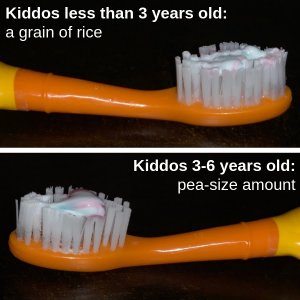
Follow these tips to make sure your little one’s teeth are getting the care they need:
- Be flexible and try a few different brands/flavors. The best toothpaste for kids is the one they’ll use!
- Kids under 3 get a grain-of-rice sized amount of toothpaste.
- Kids 3 and over get a pea-size amount of toothpaste.
- Most kids lack the fine-motor skills and manual dexterity needed to brush effectively until they’re 7 years old or so — until then they may need a little help!
–Dr. John Will, Children’s Dentistry of Charlottesville
Just like adults, children need to brush for two minutes, at least twice a day – including just before bedtime. Spend 30 seconds concentrating on each quadrant of their mouth, and ensure every surface of each tooth is cleaned thoroughly. Some dentists recommend not rinsing or drinking water right after brushing, since the ingredients in your toothpaste work best if they stay on the teeth for a while.
Choosing the right toothbrush for your child’s age is also important. Our kids’ toothbrush guide explains exactly what to look for and includes some product recommendations.
As your child becomes more independent they will want to get more involved with brushing their teeth. Let them hold the toothbrush as you brush so they get used to the correct movement. Their first attempts to try it themselves won’t be very thorough, so make sure you go over everything again afterward. You should supervise brushing until age seven to make sure your child has the correct technique.
Alternatively, if your child isn’t ready for an electric toothbrush with a timer, you can try playing a two-minute video, like the one below, while they brush.
You can read our separate article about brushing if you want to know even more about how to brush your teeth properly, whether you’re an adult or a child.
Avoiding sugary foods
As we mentioned above, good oral hygiene is only part of the solution to preventing decay. Your child’s diet also has a direct impact on the state of their teeth. In particular, sugary and starchy foods encourage the growth of the bacteria which causes rotten teeth.
Frequency is just as important as quantity here; giving a sugary drink or treat once or twice a day with a main meal is less damaging than allowing frequent sugary snacks and drinks throughout the day.
Here are some ways you can limit exposure to sugar:

- Don’t let your child snack on sugar-rich foods like cookies, sweets, flavored yogurts, and cereal bars throughout the day.
- If your child needs snacks between meals, offer foods that are low in sugar and starch like vegetable sticks or cheese (more ideas in the table below).
- Fruit juice and dried fruits might seem like a healthy snack but they are very high in sugar. Offer as part of a meal rather than as a snack.
- Get your child used to drinking water between meals if they are thirsty.
- Don’t give sugary drinks in a bottle or sippy cup since these result in more contact with the teeth.
- Ideally, don’t give them milk at night after they have brushed their teeth since even milk contains natural sugars. If they rely on this to get settled, certainly don’t add any sweeteners like chocolate powder.
We know that in the real world you can’t stick to all of these all the time. Especially if your child is used to grazing on sugary snacks all day, it will take some time to wean them onto a healthier alternative. But now that you’re aware of the things that are most detrimental to your child’s oral health you can make more informed decisions about what they eat and drink.
When they start school
When your child starts school or goes back to school after the holidays, it can feel like you’re relinquishing some control over their oral health. It’s true that you can’t stop them from sharing a friend’s chocolate bar or bag of sweets, but you can at least make sure you’re sending them off with a tooth-friendly lunchbox each day.
Here are some ideas for tooth-friendly lunchbox snacks – and some to avoid:
Pack these: | Avoid these: |
Crunchy vegetable sticks | Chips |
Cheese cubes | Cookies and cake |
Rice cakes | Chocolate and sweets |
Fresh fruit | Dried fruit |
Seeds and nuts | Cereal bars |
Plain popcorn | Jellies |
Boiled eggs | Flavored yogurt |
Unflavored milk and water to drink | Juice and other sweetened drinks |
If in doubt, check the nutrition labels of any packaged food you buy to see how much sugar it contains. This website has some helpful information about what to look for and how to make healthier choices.
And should children brush their teeth at school? If your child has braces, it might be necessary for him or her to brush their teeth at school. Your child’s dentist or orthodontist will advise you on this.
Most dental authorities recommend brushing at least twice a day. If you’re cleaning your child’s teeth properly in the morning and before bedtime, there is no need for them to brush at school as well. However, there is no reason why they can’t take a toothbrush and brush after lunch if they feel comfortable with this.
Conclusion
Although tooth decay is a big problem for children in the US, there are plenty of other oral health conditions that may affect them. Be aware of the symptoms so you can take action as soon as you notice something is wrong.
The two biggest factors in keeping your child’s teeth healthy are proper brushing and a low-sugar diet. Here is a reminder of the tips given in this article:
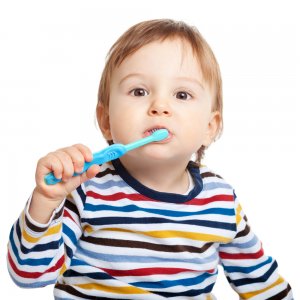
- Take your child for regular dental checkups – at least once a year or more often if advised – from age two or younger.
- Get them used to brushing twice a day as soon as their first tooth appears.
- Use a fluoride toothpaste appropriate for their age.
- Only give sugary drinks and foods at mealtimes and offer low-sugar snacks between meals, if needed.
- If they use a pacifier, try to wean them by age 1 or as soon as possible after that.
- Discourage thumb sucking as this can cause tooth misalignment.
- Once they start school, pack a tooth-friendly lunchbox to minimize exposure to sugar during the day.
The earlier children get into these good habits, the easier it is and the more likely they are to keep them up as teenagers and adults. You can also teach your kids some interesting dental facts to get them more involved.
If your child hasn’t been to the dentist for over a year (or at all!), do them a favor and get a checkup booked today by calling 866-383-0748
.CDC.gov: Children’s Oral Health. Consulted 11th May 2024.






